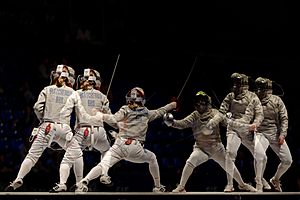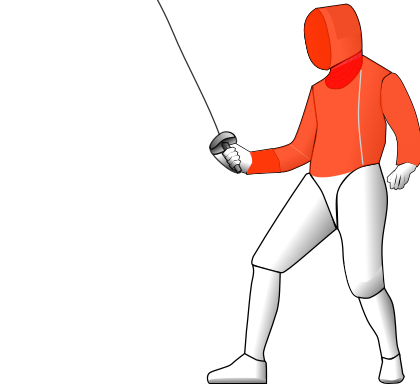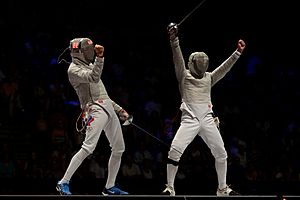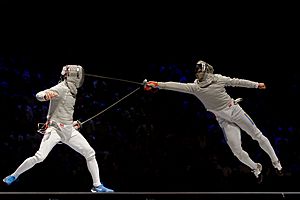Sabre (fencing) facts for kids
The sabre (say "SAY-ber") is one of the three main types of modern fencing. In sabre fencing, you can score points by hitting your opponent with the tip, the cutting edge, or even the back of the blade. This is different from the other fencing weapons, the épée and the foil, where you can only score with the tip of the blade.
A male fencer who uses the sabre is sometimes called a sabreur. A female fencer is called a sabreuse.
Contents
Understanding the Sabre Weapon
The sabre is a special sword used in fencing. It has specific rules for its size and weight.
| Name | Size | What it does | Official? |
|---|---|---|---|
| Guard | 17 × 14 × 15 cm | Protects the fencer's hand. | Yes |
| Blade | 88 cm | The steel part that hits the opponent. | Yes |
| Total length | 105 cm | The sabre's full length. | Yes |
| Total weight | 500 g | How much the sabre weighs, ready to use. | Yes |
The blade of a sabre is made of steel. It is about 88 centimeters (34.6 inches) long. The blade is usually V-shaped at the bottom and flat at the end. This design makes the blade flexible near the tip. The very end of the blade is folded over to form a small "button." This button is usually square or rectangular, about 4–6 millimeters (0.16–0.24 inches) in size.
The guard is a large, smooth, round piece that protects the fencer's hand. It is made in one piece and has no sharp edges. The inside of the guard is covered with insulation. This helps keep the fencer safe and makes sure the electrical scoring works correctly.
How Electrical Sabres Work
Modern sabres use electricity to tell when a hit happens. Underneath the bell guard, there is a socket for a body wire. This wire connects the sabre to the scoring machine. A part called a pommel holds the guard and handle in place. It also keeps the handle and guard electrically separate.
The handle of a sabre is shaped to let the fencer hold it easily. It allows the hand to slide a bit, which helps the fencer reach further. Other types of grips are not used because they would limit hand movement.
The whole sabre weapon is usually about 105 centimeters (41.3 inches) long. It weighs a maximum of 500 grams (about 1.1 pounds). Most sabres used in competitions are lighter, around 400 grams (0.88 pounds). The sabre is shorter than the foil or épée. It is also lighter than the épée. This makes it easier to move quickly. However, sabre blades can break more easily than other fencing blades because of their design.
Sabre was the last fencing weapon to start using electrical scoring. This happened in 1988. The foil started using electricity in 1956, and the épée in 1936. In 2004, the time allowed for a hit to register was changed. This made the sport faster and changed how fencers scored points.
Where to Hit in Sabre Fencing
In sabre fencing, you can score a point by hitting your opponent on their upper body. This includes their torso (chest and back) above the waist, their head, and their arms up to the wrist. You cannot score points by hitting the legs, hands, or feet.
To make sure hits are counted, fencers wear special gear:
- Glove: The glove has a conductive (electricity-carrying) cuff. This cuff touches the lamé.
- Lamé: This is a special jacket that conducts electricity. It covers the fencer's torso and arms. It stops at the waist.
- Mask: The mask also conducts electricity. It connects to the lamé with a wire and a crocodile clip.
Since you can score with the edge of the blade, the sabre blade does not need a pressure-sensitive tip like the foil or épée. When fencing with an electric sabre, a small current runs through the blade. When the blade touches the opponent's lamé, electric mask, or glove cuff, the current flows. This tells the scoring machine that a hit has happened.
How Scoring Works
A special scoring machine helps the referee decide who scored a point. This machine shows lights (red or green for each fencer) and makes sounds when a hit is made. A short ring or a continuous sound tells everyone a hit happened.
Sometimes, a white light appears. This means a fencer hit an area that is not a valid target.
Understanding the Lockout Period
The "lockout period" is a very short time set in the scoring machine. It is the minimum time between two hits. This helps the referee make fair decisions.
After the 2016 Olympic Games, the lockout time was changed. It went from 120 milliseconds (ms) to 170 ms. (A millisecond is one-thousandth of a second, so these are very short times!) Scoring machines with this new setting have a special "FIE 2016" label.
- If two hits happen, and the time between them is longer than the lockout period, only one light shows up. The referee will usually give the point to the fencer who hit first.
- If two hits happen within the lockout period, both lights show up. In this case, the referee uses a rule called 'right of way' to decide who gets the point.
Changing the lockout time made sabre fencing faster. It put more focus on quick footwork. Some fencers did not like the change at first. They felt it made the sport less artistic. But over time, fencers adapted. The new timings encouraged smaller, more precise movements. This made sabre fencing even faster and more accurate.
The Right of Way Rule
When both fencers hit at the same time (and both lights go on), the referee uses the "right of way" rule. This rule gives the point to the fencer who had priority. Usually, this is the fencer who started an attack correctly.
Here are some ways a fencer can gain the right of way:
- Attacking first: Starting an attack by extending your arm and threatening your opponent's target.
- Beating the blade: Hitting your opponent's blade first, then attacking.
- Point in line: Holding your arm straight and your point aimed at your opponent's chest before they start their attack. If your opponent tries to attack you while you have "point in line," they must move your blade aside first.
- Defending and hitting back: Making an immediate counter-attack after your opponent's attack fails. This could be after you block their attack (a parry-riposte) or if their attack misses.
If neither fencer has the "right of way" in a double hit (for example, if both attack at exactly the same time), no point is given. The action is called a "simultaneous attack."
The right of way rules help make fencing fair. They encourage fencers to use smart techniques to hit without being hit themselves.
The Referee's Role
The referee is in charge of the match. They can stop the action for safety, if a fencer gets hurt, or if someone breaks a rule. When the referee says "halt," no more points can be scored.
If a fencer breaks a rule, the referee might give a warning or show a penalty card:
- Yellow card: This is a warning. The fencer's hit might not count. For example, a yellow card can be given if a fencer moves too early or keeps acting after "halt."
- Red card: This is a more serious penalty. The fencer's hit usually does not count, and the opponent gets a point. Getting two yellow cards also leads to a red card.
- Black card: This is the most serious penalty. The fencer is removed from the tournament. This can happen for very serious rule breaks, like refusing to salute or cheating.
Referees often use French words to score the match. But in many places, they use the local language. In international competitions, referees must use French. They also use hand signals to show what happened. This helps everyone understand, even if there is a language barrier.
Sabre Fencing Techniques
Sabre fencing is often very fast. It is usually easier to attack than to defend. High-level sabre matches are quick and exciting.
To keep the sport safe and fair, some rules about movement were changed. For example, fencers are not allowed to do a "forward cross-over" (where the back foot crosses in front of the front foot). This means the "flèche" attack, which is a running attack, is not allowed. Instead, sabre fencers use a "flunge" (flying lunge). In a flunge, the fencer pushes off the ground and moves forward quickly to hit before their feet cross.
Sabre defense involves several main parries (blocks):
- Tierce (say "tee-AIRS"): Blocks attacks high and to the outside.
- Quarte (say "KART"): Blocks attacks high and to the inside (chest area).
- Quinte (say "KANT"): Blocks attacks to the head.
There are also other parries, like Prime, Seconde, and Sixte. These parries help cover different parts of the target area.
Another parry, called "the Hungarian," is used when both fencers rush towards each other. The fencer uses a sweeping motion to block attacks and cover almost the entire target area.
Sabre parries are meant to block an incoming attack directly. Fencers try to make their parries as late as possible. This stops them from falling for fake attacks.
"Circles" are also used to defend against stabs to the body. These are very useful because they cover a large part of the target area.
Fencers can also use their body with the blade for defense. For example, a fencer might jump in the air and block with a "Seconde" parry. This can help them block an attack while gaining a height advantage. Another move is to squat down and use a "Quinte" parry. This makes the fencer a smaller target and protects their weak points.
Each fencing weapon has a different speed. Épée and foil can be slow with sudden bursts of speed. Sabre, however, is fast throughout the entire match. Many coaches now teach fencers to use smaller steps to control the pace.
See also
 In Spanish: Sable (esgrima) para niños
In Spanish: Sable (esgrima) para niños








